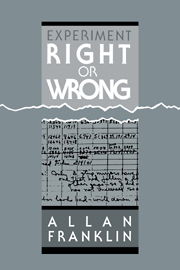Book contents
- Frontmatter
- Contents
- Preface
- Acknowledgments
- Introduction
- I EXPERIMENT AND THE DEVELOPMENT OF THE THEORY OF WEAK INTERACTIONS: FROM FERMI TO V-A
- 1 Fermi's theory
- 2 Toward a universal Fermi interaction; muons and pions
- 3 Beta-decay theory following World War II
- 4 The discovery of parity nonconservation
- 5 The V-A theory of weak interactions and its acceptance
- II TOWARD A PHILOSOPHY OF EXPERIMENT
- Conclusion
- Appendix
- References
- Index
- Frontmatter
- Contents
- Preface
- Acknowledgments
- Introduction
- I EXPERIMENT AND THE DEVELOPMENT OF THE THEORY OF WEAK INTERACTIONS: FROM FERMI TO V-A
- 1 Fermi's theory
- 2 Toward a universal Fermi interaction; muons and pions
- 3 Beta-decay theory following World War II
- 4 The discovery of parity nonconservation
- 5 The V-A theory of weak interactions and its acceptance
- II TOWARD A PHILOSOPHY OF EXPERIMENT
- Conclusion
- Appendix
- References
- Index
Summary
The fallibility and corrigibility of experimental results, of theoretical calculation, and of the comparison between experiment and theory will be amply illustrated in the episode to be discussed. This section will deal with the relation between experiment and theory in the field of weak interactions during the period between Fermi's proposal of his theory of β decay in 1934 and the acceptance of the V-A theory of weak interactions in 1959. Part of the fascination of this story is that the V-A theory appeared to be refuted by existing experimental evidence at the time it was proposed by Sudarshan and Marshak (1957) and by Feynman and Gell-Mann (1958). The authors, themselves, recognized this and suggested that the experimental results might be wrong, a suggestion that turned out to be correct. Nevertheless the theory was proposed because it seemed to be the only available candidate for a universal theory of the weak interaction. In this section I will examine the origin and development of this idea of a universal theory of the weak interaction to the acceptance of the V-A theory as such a theory.
Fermi's (1934a, 1934b) theory of β decay was introduced in 1934. It was not the first quantitative theory of β decay. Beck and Sitte (1933) had formulated an earlier theory using Dirac's prediction of the positron. According to their 1933 model an electron–positron pair was created. The positron was absorbed by the nucleus and the electron emitted (or vice versa).
- Type
- Chapter
- Information
- Experiment, Right or Wrong , pp. 9 - 24Publisher: Cambridge University PressPrint publication year: 1990



